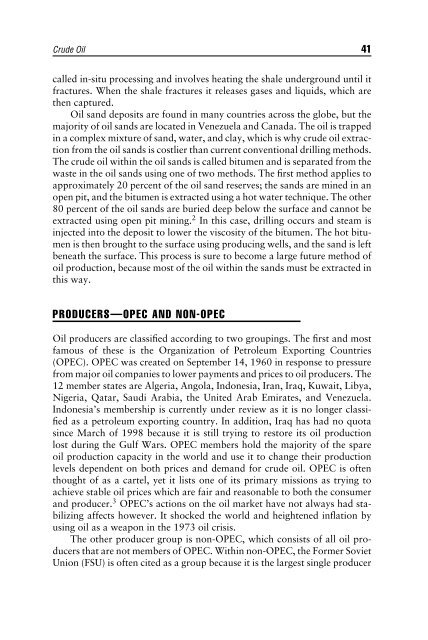Maximizing Returns through Fundamental Analysis - Arabictrader.com
Maximizing Returns through Fundamental Analysis - Arabictrader.com
Maximizing Returns through Fundamental Analysis - Arabictrader.com
Create successful ePaper yourself
Turn your PDF publications into a flip-book with our unique Google optimized e-Paper software.
Crude Oil 41<br />
called in-situ processing and involves heating the shale underground until it<br />
fractures. When the shale fractures it releases gases and liquids, which are<br />
then captured.<br />
Oil sand deposits are found in many countries across the globe, but the<br />
majority of oil sands are located in Venezuela and Canada. The oil is trapped<br />
in a <strong>com</strong>plex mixture of sand, water, and clay, which is why crude oil extraction<br />
from the oil sands is costlier than current conventional drilling methods.<br />
The crude oil within the oil sands is called bitumen and is separated from the<br />
waste in the oil sands using one of two methods. The first method applies to<br />
approximately 20 percent of the oil sand reserves; the sands are mined in an<br />
open pit, and the bitumen is extracted using a hot water technique. The other<br />
80 percent of the oil sands are buried deep below the surface and cannot be<br />
extracted using open pit mining. 2 In this case, drilling occurs and steam is<br />
injected into the deposit to lower the viscosity of the bitumen. The hot bitumen<br />
is then brought to the surface using producing wells, and the sand is left<br />
beneath the surface. This process is sure to be<strong>com</strong>e a large future method of<br />
oil production, because most of the oil within the sands must be extracted in<br />
this way.<br />
PRODUCERS—OPEC AND NON-OPEC<br />
Oil producers are classified according to two groupings. The first and most<br />
famous of these is the Organization of Petroleum Exporting Countries<br />
(OPEC). OPEC was created on September 14, 1960 in response to pressure<br />
from major oil <strong>com</strong>panies to lower payments and prices to oil producers. The<br />
12 member states are Algeria, Angola, Indonesia, Iran, Iraq, Kuwait, Libya,<br />
Nigeria, Qatar, Saudi Arabia, the United Arab Emirates, and Venezuela.<br />
Indonesia’s membership is currently under review as it is no longer classified<br />
as a petroleum exporting country. In addition, Iraq has had no quota<br />
since March of 1998 because it is still trying to restore its oil production<br />
lost during the Gulf Wars. OPEC members hold the majority of the spare<br />
oil production capacity in the world and use it to change their production<br />
levels dependent on both prices and demand for crude oil. OPEC is often<br />
thought of as a cartel, yet it lists one of its primary missions as trying to<br />
achieve stable oil prices which are fair and reasonable to both the consumer<br />
and producer. 3 OPEC’s actions on the oil market have not always had stabilizing<br />
affects however. It shocked the world and heightened inflation by<br />
using oil as a weapon in the 1973 oil crisis.<br />
The other producer group is non-OPEC, which consists of all oil producers<br />
that are not members of OPEC. Within non-OPEC, the Former Soviet<br />
Union (FSU) is often cited as a group because it is the largest single producer










